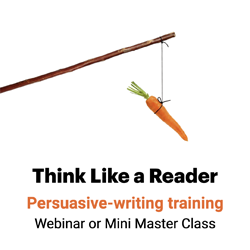Avoid Institutional Narcissism
Richard Roll, an economics professor at the University of California, Los Angeles, studies narcissism in CEOs. Turns out the more narcissistic executives are, the more likely they are to overrate their skills and make bad business moves.

In one study, Roll used a simple technique that’s been validated by psychologists to gauge executive narcissism: He counted the number of “I’s” they used in their communications.
The first-person pronoun — “the vertical pronoun,” as Pulitzer Prize-winning journalist Jacqui Banaszynski calls it — is bad enough. Its cousin, the first-person-plural “we,” is a symptom of another disorder: We-We Syndrome, or organization-focused, not reader-focused, writing.
Are you suffering from We-We Syndrome? Here are three techniques for diagnosing your copy:
1. Run the we-you test.
Use Microsoft Word’s “find” function to search for instances of company references versus reader references. Aim for a ratio of at least two reader references to one company reference.
Here are the results I got on one of my clients’ proposals:
|
We-you ratio |
|||
| Our company name | 7 | Client company name | 4 |
| “Our” | 39 | “Your” | 0 |
| “We” | 43 | “You” | 2 |
It’s a good thing we had a chance to edit the proposal before it went out: We-We Syndrome can be fatal to business development.
As one of my clients says, “You’ll go ‘We, We, We’ all the way home — without the contract.”
2. See what you say.
One way to visualize We-We Syndrome is to create a tag cloud for your copy. Tag clouds display the words you use the most frequently in the largest type, those you use less often in smaller type.
You’re looking for your customer, the word “you” and benefits-oriented verbs to show up in large type and your own company and product names to be smaller. Here’s the tag cloud for a Federal Home Loan Bank release about apartments for special-needs residents:

Remember, write about your readers, not your topic. If you find results like these, rewrite your copy to focus more on your customers and what they’ll be able to do with your product and less on the organization and the product itself.
3. Put the reader first.
Did these diagnostics reveal a bad case of Institutional Narcissism? One way to cure the disease is to lead with the reader, not with your company. Check out this before and after by Melanie Allen, Marketing & Public Relations manager at Inova.
Before:
Inova Loudoun Hospital has multiple emergency rooms around Loudoun County.
After:
Spend less time in the car and in pain with Inova Loudoun Hospital’s three conveniently located emergency rooms.
Can’t use “you”? Use a placeholder instead. Start your headline, lead, paragraph or sentence with your target reader: “Asthma sufferers,” say, or “PR professionals.”
Take the cure
We-We Syndrome is contagious, so be careful out there. Don’t let We-We spread. The minute you’ve diagnosed the patient, apply the remedy: Rewrite your copy to focus on the reader, not the organization.

Leave a Reply